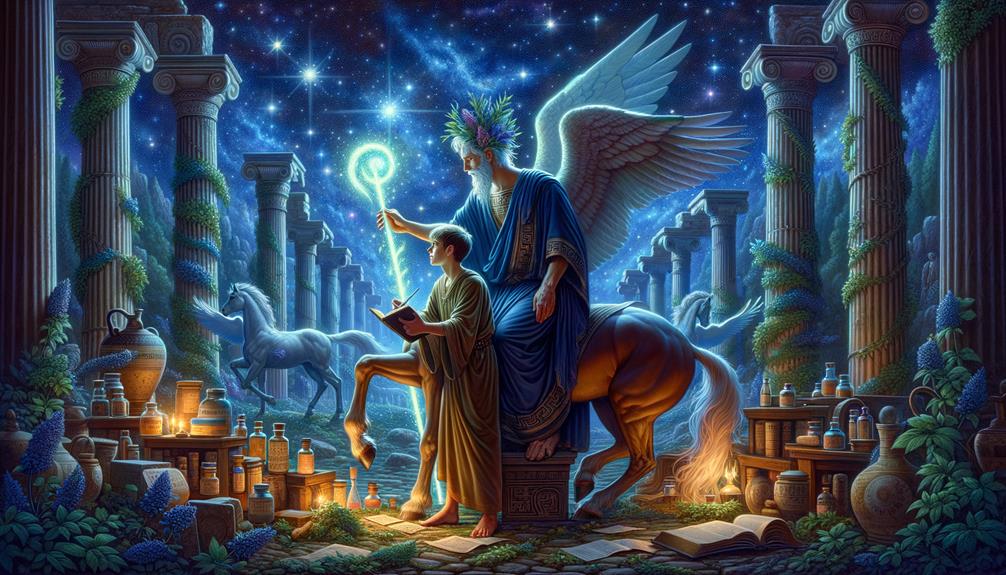Asclepius, born under Apollo's divine influence, embodied the healer's path. Rescued at birth and mentored by the wise centaur Chiron, he mastered unrivaled medical skills, bridging mortal and immortal realms. His practices, from curing illnesses to restoring life, symbolized hope and transformation. The serpent-entwined Rod of Asclepius represented wisdom and the cyclical nature of healing. People flocked to his temples, seeking his healing touch. As his legacy endures, the journey towards health and wholeness continues…
Origins and Birth
Tricca, a town steeped in myth, witnessed the extraordinary birth of Asclepius. Apollo, the divine god, sired Asclepius with Coronis, a mortal woman, blurring the lines between the mortal and celestial realms. This union set the stage for Asclepius's destiny as the Greek god of healing. Coronis's infidelity, however, led to tragedy. Enraged, Apollo ended her life but couldn't bear the thought of losing his unborn child.
In an unprecedented act, Apollo performed a Cesarean section, rescuing Asclepius from Coronis's lifeless body. This symbolized Asclepius's entry into the world through a blend of suffering and salvation. Apollo entrusted the infant to Chiron, the centaur revered for his expertise in medicine and healing.
Asclepius's birth also carried mystical potency. Athena gifted him Gorgon blood, possessing both lethal and life-giving properties, foreshadowing his role in the delicate balance between life and death. His origins intertwined divine power, mortal vulnerability, and the promise of unparalleled healing abilities.
Training With Chiron

Under Chiron's mentorship, Asclepius honed the healing arts, seamlessly integrating divine insight with earthly expertise. The wise centaur guided Asclepius through intricate medical concepts, from surgical techniques to herbal remedies, imparting comprehensive knowledge.
Chiron's teachings transformed Asclepius' approach. He learned to view patients holistically, considering both body and soul, elevating his practice beyond technical mastery. This integration earned him legendary status as a healer attuned to the whole human experience.
Symbolically, Chiron bridged the mortal and divine realms. His mentorship unveiled sacred insights, allowing Asclepius to develop unparalleled abilities. This period wasn't merely instructional; it was a transformative journey shaping Asclepius into Greek mythology's quintessential healer.
Chiron nurtured Asclepius' empathetic nature alongside clinical excellence. Under this tutelage, the pupil became a compassionate figure, revered for his profound understanding of the human condition. Their bond exemplified the profound impact mentors can have, guiding pupils to extraordinary heights through shared wisdom and care.
Miracles and Healing

Asclepius, the Greek god of healing, had skills that were the stuff of legends. Stories abound of his superhuman abilities – from treating everyday ailments to executing complex surgical procedures and even reviving the dead. His holistic approach utilized herbs, surgical methods, and elements of the divine.
Under Chiron's expert guidance, Asclepius mastered the art of healing. His miracles embodied the delicate balance between earthly expertise and heavenly influence, reminding us that true healing extends beyond the physical realm.
| Aspect | Description |
|---|---|
| Healing Prowess | Unrivaled expertise in medicine |
| Techniques | Botanical remedies, surgical interventions, divine aid |
| Followers' Faith | Belief in his curative and restorative powers |
| Symbolic Meaning | Union of mortal skill and celestial forces |
Word of Asclepius's phenomenal gifts spread rapidly, attracting followers seeking relief through divine intervention. His supposed ability to resurrect the deceased became a profound symbol of hope and rebirth. Each attributed miracle solidified his legacy as a timeless Greek mythological figure – a personification that healing transcends science, an art imbued with otherworldly essence.
Symbols and Significance

When reflecting on Asclepius, the serpent-entwined staff immediately stands out – an enduring icon representing healing and medicine. Once symbolizing danger due to venomous bites, the serpent now signifies rejuvenation and the arduous path to recovery. This potent emblem, distinct from Hermes' Caduceus, encapsulates the essence of health and the sacred calling of medical professionals.
Contemporary journalists would likely express this idea more concisely:
Asclepius' serpent-wrapped staff symbolizes healing's trials and triumphs. Once feared for its deadly bites, the serpent now represents rejuvenation after illness. This ancient icon captures medicine's profound purpose, distinct from Hermes' caduceus.
Rod of Asclepius
Among ancient Greek symbols, the Rod of Asclepius stands tall, embodying healing and medical expertise. As the son of Apollo and Greek God of Medicine, Asclepius carried this staff, adorned with a solitary serpent, signifying his prowess in treating the sick. Although Asclepius was slain by his sister Artemis, his followers kept his legacy alive, revering the rod as a representation of renewed life and ceaseless pursuit of wellness.
Today, healthcare workers worldwide display the Rod of Asclepius, continuing to honor Asclepius' lasting impact. This timeless icon guides those dedicated to the healing arts, reminding them of the ancient wisdom that endures in modern medicine.
Serpents and Healing
In ancient Greek mythology, the serpents twisting around the Rod of Asclepius symbolized healing, wisdom, and life's cyclical nature. Asclepius, the medicine deity, carried this staff to showcase his ability to cure illnesses and restore health. Snakes shed their skin, representing rejuvenation and transformation, mirroring the healing journey.
This symbolism wasn't accidental. Greeks revered serpents for their perceived wisdom and connection to the earth, viewing them as intermediaries between mortals and the divine. By including these creatures on his Rod, Asclepius highlighted the delicate balance between life and death in healing. The intertwined serpents suggest the duality of medical practice—wisdom and skill must coexist to facilitate true renewal.
The Rod of Asclepius, adorned with serpents, became a powerful symbol of transformation and renewal. It reminds us that healing involves more than physical actions; it's a profound journey encompassing wisdom, balance, and the eternal cycle of life and death.
Worship and Temples

Drawn by their devotion to Asclepius, the divine healer, pilgrims journeyed to temples like Epidaurus and Kos, where sacred rituals involving dogs and harmless snakes stood central. These healing sanctuaries became havens for those seeking the god's grace, with petitioners believing divine dreams or animal touch would guide their recovery.
At Asclepius temples, healing practices blended symbolism and therapy. The faithful held firm that Asclepius himself would intervene, restoring health and wholeness. Celebrations like Athens' Festival Epidauria reinforced this conviction and community bonds.
Ancient Greek artifacts depict Asclepius, underscoring his integral role in these rituals. Temples in cities such as Miletus, Hyperteleatum, Hypsi, and Hyettus provided respite for the ill, embodying the timeless human pursuit of healing and divine favor through transformative journeys.
Legacy and Influence

As we examine Asclepius' journey from myth to modern times, his influence remains deeply woven into healthcare practices and philosophies. The ancient symbol of his rod and serpent, once an object of reverence, now universally represents healing. Asclepius' impact extends far beyond symbolism, shaping the very core of how we approach medicine today.
Medical Symbol Origin
The Rod of Asclepius, an ancient symbol originating from Greek mythology, maintains significance in modern medical practices. Asclepius, the Greek deity of healing, carried this staff with a single serpent coiled around it. The serpent represented wisdom, renewal, and the intricate balance between life and death – principles fundamental to healthcare.
This iconic image transcends cultures and eras, emerging as a universal symbol of healing:
| Symbol | Meaning |
|---|---|
| Rod | Authority and guidance |
| Serpent | Rebirth and understanding life's cycles |
| Asclepius | The practice of medicine |
| Greek roots | Medicine's cultural heritage |
The serpent, often misunderstood, symbolizes not malice but insight into the natural order. This duality reflects a physician's role – preserving life while comprehending its finite nature.
Today, the Rod of Asclepius remains a powerful emblem inspiring healthcare professionals. It connects modern practices to ancient wisdom, embodying the timeless human quest for healing.
Modern Healing Practices
The ancient healing practices of Asclepius continue shaping modern medicine, highlighting the profound link between age-old wisdom and contemporary healthcare. The Rod of Asclepius, a staff with a serpent coiled around it, remains a powerful symbol within the medical field. It isn't mere decoration; deeply rooted in Greek and Roman healing traditions, it represents Asclepius's lasting influence on healthcare.
Nowadays, the Rod of Asclepius adorns medical uniforms, ambulances, and facilities globally. This ancient symbol guides practitioners on their noble mission to heal. Organizations like the World Health Organization include it in their logos, showcasing their global health commitment.
The Hippocratic Oath's ethical framework, emphasizing patient care and confidentiality, also reflects Asclepius's principles. When physicians swear this oath, they affirm the timeless wisdom carried forward from ancient healing arts. Asclepius's legacy inspires healthcare professionals dedicated to alleviating suffering and promoting wellness, bridging past and present in an unbroken healing journey.
Frequently Asked Questions
How Does Asclepius Heal?
My healing methods combine natural herbs, surgical techniques, and spiritual rituals. Athena showed me how to use gorgon blood, and I recite incantations and prayers during treatments. Represented by the Rod of Asclepius, my skills even cure venomous snakebites.
Who Was the Greek God of Healing?
Picture a divine healer brandishing a serpent-entwined staff in ancient Greece. Asclepius, Apollo's son, mythically embodied triumph over illness, his legacy representing medicine's conquest over affliction.
Why Was Asclepius Killed by Zeus?
Zeus striking down Asclepius with a thunderbolt represents the consequences of mortals overstepping boundaries set by higher powers. Asclepius's ability to resurrect the dead challenged nature's rules. His bold actions illustrated how human arrogance and pushing limits too far can provoke severe punishment and upheaval from forces beyond our control.
Is Asclepius Good or Bad?
Asclepius's compassion and healing prowess made him a celebrated figure. However, his resurrection of the dead breached the natural order, muddying ethical lines. This defiant act challenged divine authority, leaving his morality open to debate.


